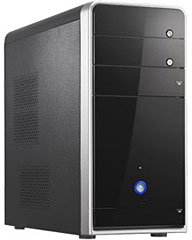In the news this week: a small Florida-based company, Psystar offered customers what it
promised were Mac OS X compatible PC clones for $399. For about
half the price of a low-end Mac
mini, Psystar's Open Computer offered a faster and bigger hard
drive, a more powerful dedicated graphics card, and expandability in a
generic PC clone tower case.
No operating system for that price, though. Psystar noted:
"With the EFI V8 emulator it is possible to install
Leopard's kernel straight from the DVD that you purchased at the Apple
Store barring the addition of a few drivers to ensure that everything
boots and runs smoothly,"
The company also offered copies of Leopard for $150, and if you
bought it from them, they would install it.
 What's the catch? Ever since
Apple canceled its clone licensing
program in the late 1990s, the various versions of the Mac
operating system have included a clause that customers could only run
it on Apple-branded hardware.
What's the catch? Ever since
Apple canceled its clone licensing
program in the late 1990s, the various versions of the Mac
operating system have included a clause that customers could only run
it on Apple-branded hardware.
By the afternoon of April 14th, the company's
Open Computer webpage was no longer responding. Perhaps it was
overwhelmed by the response after the news got out, but I wouldn't be
surprised if they'd heard from Apple's lawyers.
A little Mac-history:
In 1994 (in the era of System 7.x), Apple announced that it would
allow non-Apple computer manufacturers to license the then-current Mac
operating system. The company's hope was that these other companies
would help grow the market for Mac OS-powered systems in market niches
where Apple was not reaching out.
Several companies, including Umax, Motorola, and others paid Apple's licensing
fees. By 1996, they accounted for about 10% of all Macs sold worldwide.
In that same year, however, Apple's sales were some 30% lower than the
year before.
While Apple's hope had been that the clones would bring the joy of
Mac to new markets, apparently the bulk of the clone sales were to
people replacing an older Mac - in other words, Apple's core customer
base. With Mac-compatible systems that were either cheaper or more
powerful than official Apple models, that should have been no surprise.
(In this era, I owned a Motorola StarMax, built around a 160 MHz
PowerPC 603e CPU. It used PC-style VGA displays and a PS/2 mouse and
keyboard but ran Mac OS 7.5.3 and all the Mac software I could throw at
it just fine).
Upon Steve Jobs' 1997 return to Apple, he realized that this was a
problem for the company; Apple was primarily a hardware company, and
there was a lot more profit in selling a Mac than in getting what has
been estimated as a $25 licensing fee when Motorola or Umax sold a Mac
clone. One of his first acts as Apple CEO was to announce that the
clone licenses were not going to be renewed past early 1998, and that
even existing licensees weren't going to be allowed to offer new
versions of the Mac OS starting with Mac OS 7.6.
Apple has ignored calls to make the Mac operating system available
to other companies ever since.
It was harder to make a clone Mac back then; much of what made a Mac
a Mac was hard-wired into the computer's ROM chips. More recently,
though, this code was moved to software. And even more recently, Apple
switched from using PowerPC CPUs to Intel chips - the same sort of CPUs
found in most Windows PCs. In fact, today's Macs are arguably standard
PCs in fancy cases - and they can even be set up to boot to Windows XP
or Vista using Apple's Boot Camp installer.
Perhaps it is not surprising, then, that there's an underground "Hackintosh"
movement devoted to the tricks needed to build a do-it-yourself PC
that can boot to Mac OS X. I haven't done it, so please don't ask
me for advice. As long as the movement remained do-it-yourself, Apple
seemed to be leaving it alone. But in offering products for sale - and
in getting a fair bit of media attention - Psystar apparently crossed a
line.
Psystar's "Open Computer" does suggest that there is a market for a
lower-priced, expandable Mac - but will Apple listen.


 What's the catch? Ever since
Apple
What's the catch? Ever since
Apple 
